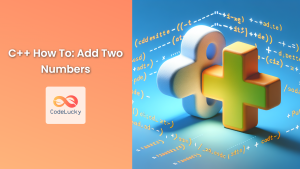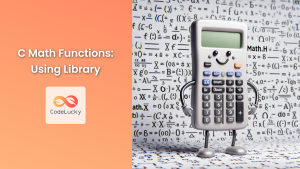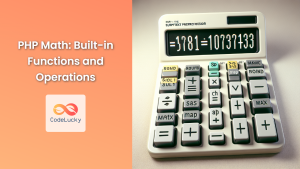C++ provides a robust set of mathematical functions and operations that are essential for various computational tasks. Whether you're developing scientific applications, game engines, or financial software, understanding these math functions is crucial. In this comprehensive guide, we'll explore the vast array of mathematical capabilities offered by C++, complete with practical examples and in-depth explanations.
Basic Arithmetic Operations
Before diving into more complex mathematical functions, let's review the basic arithmetic operations in C++. These fundamental operations form the building blocks of more sophisticated calculations.
#include <iostream>
int main() {
int a = 10, b = 3;
std::cout << "Addition: " << a + b << std::endl;
std::cout << "Subtraction: " << a - b << std::endl;
std::cout << "Multiplication: " << a * b << std::endl;
std::cout << "Division: " << a / b << std::endl;
std::cout << "Modulus: " << a % b << std::endl;
return 0;
}
Output:
Addition: 13
Subtraction: 7
Multiplication: 30
Division: 3
Modulus: 1
🔍 Note: The division operation between two integers results in integer division, truncating any decimal part. For floating-point division, at least one operand must be a floating-point type.
The <cmath> Header
C++ provides a wealth of mathematical functions through the <cmath> header. This header contains a wide range of functions for common mathematical operations. Let's explore some of the most frequently used functions:
Power and Root Functions
#include <iostream>
#include <cmath>
int main() {
double base = 2.0, exponent = 3.0;
std::cout << "pow(2.0, 3.0): " << std::pow(base, exponent) << std::endl;
std::cout << "sqrt(16.0): " << std::sqrt(16.0) << std::endl;
std::cout << "cbrt(27.0): " << std::cbrt(27.0) << std::endl;
return 0;
}
Output:
pow(2.0, 3.0): 8
sqrt(16.0): 4
cbrt(27.0): 3
🔬 The pow() function calculates the power of a number, sqrt() computes the square root, and cbrt() calculates the cube root.
Exponential and Logarithmic Functions
#include <iostream>
#include <cmath>
int main() {
double x = 2.0;
std::cout << "exp(2.0): " << std::exp(x) << std::endl;
std::cout << "log(2.0): " << std::log(x) << std::endl;
std::cout << "log10(100.0): " << std::log10(100.0) << std::endl;
return 0;
}
Output:
exp(2.0): 7.38906
log(2.0): 0.693147
log10(100.0): 2
📊 exp() calculates the exponential function (e^x), log() computes the natural logarithm, and log10() calculates the base-10 logarithm.
Trigonometric Functions
C++ provides a complete set of trigonometric functions. Here's an example demonstrating some of them:
#include <iostream>
#include <cmath>
int main() {
double angle = M_PI / 4; // 45 degrees in radians
std::cout << "sin(π/4): " << std::sin(angle) << std::endl;
std::cout << "cos(π/4): " << std::cos(angle) << std::endl;
std::cout << "tan(π/4): " << std::tan(angle) << std::endl;
return 0;
}
Output:
sin(π/4): 0.707107
cos(π/4): 0.707107
tan(π/4): 1
🔄 Remember that these functions work with angles in radians. To convert degrees to radians, multiply by π/180.
Hyperbolic Functions
C++ also provides hyperbolic functions, which are analogous to trigonometric functions but based on hyperbolas instead of circles:
#include <iostream>
#include <cmath>
int main() {
double x = 1.0;
std::cout << "sinh(1.0): " << std::sinh(x) << std::endl;
std::cout << "cosh(1.0): " << std::cosh(x) << std::endl;
std::cout << "tanh(1.0): " << std::tanh(x) << std::endl;
return 0;
}
Output:
sinh(1.0): 1.1752
cosh(1.0): 1.54308
tanh(1.0): 0.761594
🌈 Hyperbolic functions have applications in various fields, including physics and engineering.
Rounding Functions
C++ offers several functions for rounding floating-point numbers:
#include <iostream>
#include <cmath>
int main() {
double x = 3.7, y = -2.1;
std::cout << "ceil(3.7): " << std::ceil(x) << std::endl;
std::cout << "floor(3.7): " << std::floor(x) << std::endl;
std::cout << "round(3.7): " << std::round(x) << std::endl;
std::cout << "trunc(3.7): " << std::trunc(x) << std::endl;
std::cout << "ceil(-2.1): " << std::ceil(y) << std::endl;
std::cout << "floor(-2.1): " << std::floor(y) << std::endl;
std::cout << "round(-2.1): " << std::round(y) << std::endl;
std::cout << "trunc(-2.1): " << std::trunc(y) << std::endl;
return 0;
}
Output:
ceil(3.7): 4
floor(3.7): 3
round(3.7): 4
trunc(3.7): 3
ceil(-2.1): -2
floor(-2.1): -3
round(-2.1): -2
trunc(-2.1): -2
🎯 ceil() rounds up, floor() rounds down, round() rounds to the nearest integer, and trunc() truncates the decimal part.
Absolute Value and Sign Functions
C++ provides functions to compute the absolute value and determine the sign of a number:
#include <iostream>
#include <cmath>
int main() {
double x = -5.5;
int y = -10;
std::cout << "abs(-5.5): " << std::abs(x) << std::endl;
std::cout << "fabs(-5.5): " << std::fabs(x) << std::endl;
std::cout << "abs(-10): " << std::abs(y) << std::endl;
std::cout << "signbit(-5.5): " << std::signbit(x) << std::endl;
std::cout << "copysign(5.5, -3.0): " << std::copysign(5.5, -3.0) << std::endl;
return 0;
}
Output:
abs(-5.5): 5.5
fabs(-5.5): 5.5
abs(-10): 10
signbit(-5.5): 1
copysign(5.5, -3.0): -5.5
💡 abs() works for both integer and floating-point types, while fabs() is specifically for floating-point numbers. signbit() returns true for negative numbers, and copysign() copies the sign of the second argument to the first.
Minimum and Maximum Functions
C++ provides functions to find the minimum and maximum of two numbers:
#include <iostream>
#include <algorithm>
int main() {
int a = 5, b = 10;
double x = 3.14, y = 2.71;
std::cout << "min(5, 10): " << std::min(a, b) << std::endl;
std::cout << "max(5, 10): " << std::max(a, b) << std::endl;
std::cout << "min(3.14, 2.71): " << std::min(x, y) << std::endl;
std::cout << "max(3.14, 2.71): " << std::max(x, y) << std::endl;
return 0;
}
Output:
min(5, 10): 5
max(5, 10): 10
min(3.14, 2.71): 2.71
max(3.14, 2.71): 3.14
🔢 These functions work with any type that supports comparison operations.
Error and Gamma Functions
C++ also provides some special mathematical functions, such as the error function and the gamma function:
#include <iostream>
#include <cmath>
int main() {
double x = 1.0;
std::cout << "erf(1.0): " << std::erf(x) << std::endl;
std::cout << "erfc(1.0): " << std::erfc(x) << std::endl;
std::cout << "tgamma(5.0): " << std::tgamma(5.0) << std::endl;
std::cout << "lgamma(5.0): " << std::lgamma(5.0) << std::endl;
return 0;
}
Output:
erf(1.0): 0.842701
erfc(1.0): 0.157299
tgamma(5.0): 24
lgamma(5.0): 3.17805
📐 The error function (erf) and its complement (erfc) are used in probability, statistics, and partial differential equations. The gamma function (tgamma) and its natural logarithm (lgamma) are extensions of the factorial function to real and complex numbers.
Floating-Point Manipulation
C++ provides functions for manipulating the bits of floating-point numbers:
#include <iostream>
#include <cmath>
int main() {
double x = 3.14;
double y = 2.0;
std::cout << "frexp(3.14, exp): " << std::frexp(x, &y) << ", " << y << std::endl;
std::cout << "ldexp(0.785, 2): " << std::ldexp(0.785, 2) << std::endl;
std::cout << "modf(3.14, iptr): " << std::modf(x, &y) << ", " << y << std::endl;
return 0;
}
Output:
frexp(3.14, exp): 0.785, 2
ldexp(0.785, 2): 3.14
modf(3.14, iptr): 0.14, 3
🔬 frexp() breaks a number into a normalized fraction and an integer power of 2, ldexp() multiplies a number by 2 raised to a power, and modf() breaks a number into integer and fractional parts.
Practical Example: Solving a Quadratic Equation
Let's put our knowledge of C++ math functions to use by solving a quadratic equation (ax² + bx + c = 0):
#include <iostream>
#include <cmath>
void solveQuadratic(double a, double b, double c) {
double discriminant = b*b - 4*a*c;
if (discriminant > 0) {
double root1 = (-b + std::sqrt(discriminant)) / (2*a);
double root2 = (-b - std::sqrt(discriminant)) / (2*a);
std::cout << "Two real roots: " << root1 << " and " << root2 << std::endl;
} else if (discriminant == 0) {
double root = -b / (2*a);
std::cout << "One real root: " << root << std::endl;
} else {
double realPart = -b / (2*a);
double imaginaryPart = std::sqrt(-discriminant) / (2*a);
std::cout << "Complex roots: " << realPart << " + " << imaginaryPart << "i and "
<< realPart << " - " << imaginaryPart << "i" << std::endl;
}
}
int main() {
solveQuadratic(1, -5, 6); // x² - 5x + 6 = 0
solveQuadratic(1, -2, 1); // x² - 2x + 1 = 0
solveQuadratic(1, 2, 5); // x² + 2x + 5 = 0
return 0;
}
Output:
Two real roots: 3 and 2
One real root: 1
Complex roots: -1 + 2i and -1 - 2i
🧮 This example demonstrates how we can combine various math functions (sqrt(), arithmetic operations) to solve a real-world problem.
Conclusion
C++ offers a comprehensive set of mathematical functions that cater to a wide range of computational needs. From basic arithmetic to complex mathematical operations, C++ provides the tools necessary for sophisticated numerical computations. By mastering these functions, you'll be well-equipped to tackle various mathematical challenges in your C++ programs.
Remember to always include the appropriate headers (<cmath> for most mathematical functions) and use the std:: namespace when calling these functions. As you continue to work with C++, you'll find these mathematical capabilities invaluable in numerous applications, from scientific simulations to game development and beyond.
🚀 Keep exploring and experimenting with these functions to deepen your understanding and unlock the full potential of C++'s mathematical prowess!

















